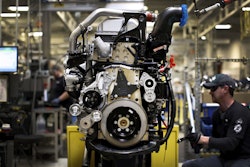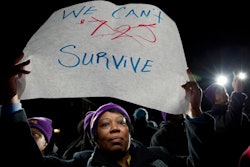CASPER, Wyo. (AP) — The bust hit Wyoming in waves.
The first rolled ashore in 1981, the year local oil prices hit $32 a barrel and the state economy was going gangbusters.
Some 20,000 people had moved to Natrona County during the previous decade, and Casper was bursting at the seams. Stories abounded of people sleeping in cars, tents or just about anywhere that wasn't a house. The census estimated more than 71,000 people called Natrona County home. Many thought that number was too low.
Few saw the warning signs at first. The decline in crude prices was like a long, gradual column of water rising slowly from the sea. Maybe it would catch the state up, spin Wyoming around like a t-shirt in a washing machine and leave its residents momentarily dazed. But it was nothing serious.
The price on a barrel of Wyoming crude was $29 in 1982. Three years later, it was $24 a barrel. The almost 130 million barrels pumped statewide was not far from the peak of 135 million barrels produced in 1978.
Then the second wave hit. Crude fell from $24 a barrel in 1985 to $12 in 1986. It was the economic equivalent of a tsunami.
Wyoming oil production fell every year between 1985 and 2005, when it reached 51.8 million barrels. There were 131 rigs drilling for oil and gas in 1984, 93 in 1985, 66 in 1986 and 40 in 1987.
The census estimated around 10,000 people left Natrona County between 1980 and 1990. Homes built in the 1970s suddenly sold for half their initial asking prices. Foreclosure auctions popped up around Casper.
State government was broke. One year, a Jackson widow died and the resulting $20 million in estate taxes was used to balance the state budget.
"It wasn't easy," said Michael Sullivan, a Democrat who served two terms as governor between 1987 and 1995. "We looked in every coffee can for additional money."
___
The parallels between the 1986 bust and the present collapse in oil prices are unmistakable.
The American benchmark for crude has tumbled by more than 50 percent since June, the summertime high of $107 a barrel replaced by sub-$50 prices at the end of February. Wyoming's rig count has mirrored the decline. The 33 drilling rigs reported the week of Feb. 27 was almost half the 62 rigs recorded as recently as November.
Natural gas and coal carried the state economy for most of the last three decades, but both have struggled in recent years amid depressed prices. Oil emerged from the doldrums around 2010, when an increase in drilling arrived just in time to rescue the state from declining natural gas and coal production. Now all three are stuck in the mud, facing short-term supply gluts and weak prices.
The dynamic raises an important question: Almost three decades after a dramatic drop in crude prices brought the state to its knees, is Wyoming better prepared to navigate another oil industry bust?
Oil's collapse threatens to test the state's savings policies and its efforts to grow its economy beyond the traditional economic linchpins of minerals, tourism and agriculture.
Many of Wyoming's present political and business leaders came of age during the lean years of the 1980s and 1990s and have been planning for a bust ever since.
The $926 million in Wyoming's rainy day account entering fiscal year 2014 was enough to run the state for 189 days, according to an analysis by the Pew Charitable Trust. Only Alaska could operate more days on reserves alone.
Wyoming's rainy day fund has since doubled and now boasts around $2 billion.
"Every time the Legislature would squirrel away more money, even in recent years, I attribute it to the hangover of that last downturn," Sullivan said. "That period certainly made us all economic conservatives."
Oil revenues alone account for 17 percent of the state's operating budget, according to an analysis by Standard & Poor's, the credit rating agency. The recent slump in crude prices is expected to cost Wyoming $231 million in revenue over the 2015-2016 budget cycle. Low natural gas prices and an uncertain future for coal compound the budgetary woes further.
Still, Wyoming's finances appear well-positioned to weather a short-term drop in oil prices, state leaders and budget analysts say. In the 2015-2016 budget cycle, spending on reserves made 57 percent of Wyoming's expenditures. Standard & Poor's hailed those efforts, saying Wyoming's savings rate will help the state ride out the choppy weather. The ratings agency gave the state an AAA credit rating, its highest designation.
The greatest question facing Wyoming is what to do with its reserves, said Brenna Erford, who manages Pew Charitable Trust's state budget policy program. The issue is especially important given the volatility in Wyoming's tax collections. Only Alaska sees greater swings in tax receipts than the Cowboy State, a phenomenon that owes itself to the pairs' reliance on energy industry severance taxes.
There are also trade-offs between saving money for tomorrow and spending it today on infrastructure projects and other initiatives that might benefit the state, Erford noted.
Nine states have established metrics that determine how much they save based on the amount of revenue collected. Generally states save more during the flush years and less during the lean ones. Ratings agencies, Erford said, tend to favor that sort of clarity.
Gov. Matt Mead, a Republican, has championed a similar idea in recent months, saying the state should better define its savings policies. Wyoming currently lacks guidelines that spell out when and how the state should spend its reserves.
"I think now, even more than during the boom times, it's a conversation we need to have. It doesn't just affect the state revenue. More importantly, people will be losing their jobs," Mead said. "Small business, restaurants, hotels, retail stores -- they're going to be affected by (low oil prices). We don't want to pull the plug on them as well because, if they leave the state, it's not like when oil prices get back to 80 bucks they come back the next day. Once we start losing businesses, it is dang hard to get them back into the state."
The idea was dealt a setback recently when lawmakers voted down a bill that would have created a committee charged with studying the issue. The topic will be one legislators look at over the interim period.
___
In the 1980s, companies like Chevron and Exxon maintained offices in Casper, where they employed teams of geologists, engineers and mid-level managers. Many were rising members of the community, taking leadership roles in organizations like the Chamber of Commerce and the Rotary Club.
Then the bust hit, and those jobs seemingly evaporated overnight.
"It had ramifications for the community for a quite a while," said Rob Hurless, who was the publisher of the Casper Star-Tribune at the time. "It changed the dynamics."
None of the so-called "majors" keeps an office in the city today. The state's largest oil producer, Anadarko Petroleum, is based in Texas and handles many of its Wyoming operations from an office in Denver. Many other companies working in the state boast similar arrangements.
It also highlights one of the major differences between the 1986 bust and oil's current slide. The industry is leaner today. There are, comparatively speaking, fewer jobs to cut. Technological advancements in exploration and production have fortified the dynamic. Many of the jobs lost in the 1980s never returned.
That is not to say Wyoming's workforce will avoid the pain of crude's descent. A trio of major oil field service providers, Halliburton, Baker Hughes and Schlumberger, has announced significant reductions in staffing as a result of depressed prices. It remains to be seen to what extent those cuts will impact Wyoming. None specified where they were pulling back and unemployment data for recent months remains unavailable.
The amount of pain Wyoming experiences will depend in part on other industries' ability to pick up the slack. The recent establishment of a series of data centers in Cheyenne highlights the growing diversity of the state economy. Casper has witnessed the growth of its health care sector. Three hospitals now call the city home.
Bob Tanner is a long-time real estate agent at Equity Brokers in Casper. He remembers well the sudden turn in the real estate market during the 1980s, when the shortage of homes turned to a surplus. Townhouses built on Eastbrook Ave in the 1970s sold for an initial price of $75,000. The same properties sold for $35,000 in the 1980s, he recalled.
But in the years since, he has witnessed an expansion in Casper's employment base. The growth of the local health care industry, Casper College and the city's retail sector have helped soften the blow of rapid swings in oil prices. Of his recent home sales, one was a nurse, another was retired and a third was a welder.
"It seems like each one of these things becomes a little less defining than the last one," Tanner said. "I think that is what is going to happen here."
The numbers support his observation. State and local government is by far the largest employer in Wyoming, making up 22 percent of the workforce. It is followed by leisure and hospitality services (12 percent) and retail (10 percent). Mining and logging is tied with education as the fourth largest employer in the state at 9 percent.
Still, those numbers understate the role the oil industry plays. Over the last eight years, Wyoming's economy grew by 5.2 percent. The U.S. economy, by comparison, grew by 2.2 percent. Much of that growth can be attributed to the recent wave of drilling in the eastern part of the state.
A slowdown in the oil field will eventually be felt in other sectors of the economy. As oil field hands lose their jobs, they will have less money to spend at hotels, restaurants or stores.
The state's fledgling technology sector, meanwhile, remains just that. In 2013, roughly 4,800 people were employed in technology, or 1.7 percent of the state's workforce. The Department of Workforce Services' Office of Research and Planning projects computer occupations will add 500 jobs between 2012 and 2020.
"We do have broader employment opportunities for our citizens, but the structure is not changed. Mineralsare NO. 1, tourism is No. 2 and ag is No. 3," said Mead. "And year in and year out, even with the diversity we've seen over the last couple of decades, revenue for the state of Wyoming is, depending upon the year, about 70 percent minerals."
The governor said he nonetheless remains optimistic about Wyoming's future, noting even the most pessimistic prognosticators don't anticipate oil prices to remain depressed for more than two years.
Sullivan, the former governor, echoed Mead's comments. The state has made great strides, but more work remains if Wyoming is to truly break the cycle of boom and bust.
Asked if the state could ever break the trend, he paused.
"If you look at the history, you'd say it's not very easy. Everyone has tried," Sullivan said. "It has always been the conundrum. We've got great resources and great cash flow as long as things are good."
Wyoming is probably as prepared as any state could be for a bust, he noted. But the amount of pain the state endures will largely depend on how long the bust lasts. Unfortunately, Sullivan said, no one knows the answer to that question.





















